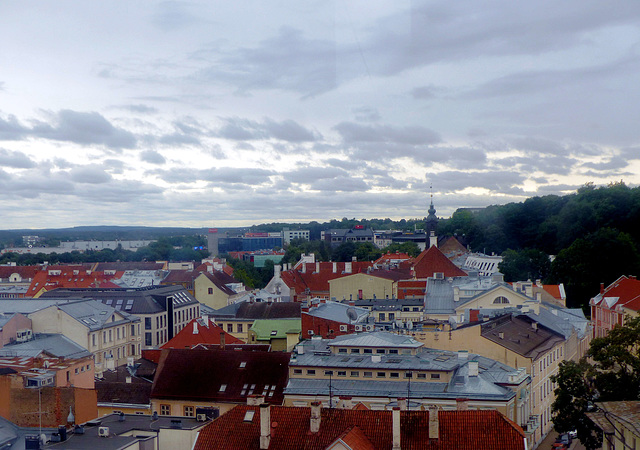Location
See also...
Keywords
Authorizations, license
-
Visible by: Everyone -
All rights reserved
-
26 visits
Tartu


Tartu (German Dorpat) is the second-largest city in Estonia, after Tallinn.
In the early 11th century Yaroslav I the Wise, Prince of Kiev, invaded the region and after a victorious battle with the locals built his own fort there, Tartu probably remained under Kievan control until 1061, when the fort was burned down by an Estonian tribe. Soon afterwards the fort was rebuilt.
During the Northern Crusades at the beginning of the 13th century, the fort was captured by the crusading Brothers of the Sword — and recaptured by Estonians. In 1224 the fort was besieged and conquered for one last time by the Teutonic crusaders. Subsequently, Dorpat became a commercial centre of considerable importance during the later Middle Ages and the capital of the semi-independent Bishopric of Dorpat.
German merchants and artisans settled alongside the bishop's fortress. In the 1280s Dorpat joined the Hanseatic League.
In 1558, tsar Ivan the Terrible invaded Tartu beginning the Livonian War. His forces encircled the town. After a heavy bombardment, the town surrendered. In 1582, the city became part of the Polish–Lithuanian Commonwealth. In 1598. A Jesuit grammar school "Gymnasium Dorpatense" was established in 1583.
In the effect of the Polish-Swedish War, in 1625 Tartu was captured by Sweden. The city became part of the Dominions of Sweden, which led to the foundation of the University of Tartu in 1632 by king Gustavus Adolphus of Sweden. So the University of Tartu is Estonia´s oldest and still most renowned university
In 1704 the town was taken by the Russian army. In 1708 the fortifications and houses, including the remains of the bishop's castle, were blown up, all movable property was looted and the citizens were deported to Russia. In 1721, the city became part of the Russian Empire and was known as Derpt. A great fire in 1775 destroyed most of the buildings in the centre. The city was rebuilt along Late Baroque and Neoclassical lines.
Tartu seen from the tower of Jaani Kirik.
Translate into English
In the early 11th century Yaroslav I the Wise, Prince of Kiev, invaded the region and after a victorious battle with the locals built his own fort there, Tartu probably remained under Kievan control until 1061, when the fort was burned down by an Estonian tribe. Soon afterwards the fort was rebuilt.
During the Northern Crusades at the beginning of the 13th century, the fort was captured by the crusading Brothers of the Sword — and recaptured by Estonians. In 1224 the fort was besieged and conquered for one last time by the Teutonic crusaders. Subsequently, Dorpat became a commercial centre of considerable importance during the later Middle Ages and the capital of the semi-independent Bishopric of Dorpat.
German merchants and artisans settled alongside the bishop's fortress. In the 1280s Dorpat joined the Hanseatic League.
In 1558, tsar Ivan the Terrible invaded Tartu beginning the Livonian War. His forces encircled the town. After a heavy bombardment, the town surrendered. In 1582, the city became part of the Polish–Lithuanian Commonwealth. In 1598. A Jesuit grammar school "Gymnasium Dorpatense" was established in 1583.
In the effect of the Polish-Swedish War, in 1625 Tartu was captured by Sweden. The city became part of the Dominions of Sweden, which led to the foundation of the University of Tartu in 1632 by king Gustavus Adolphus of Sweden. So the University of Tartu is Estonia´s oldest and still most renowned university
In 1704 the town was taken by the Russian army. In 1708 the fortifications and houses, including the remains of the bishop's castle, were blown up, all movable property was looted and the citizens were deported to Russia. In 1721, the city became part of the Russian Empire and was known as Derpt. A great fire in 1775 destroyed most of the buildings in the centre. The city was rebuilt along Late Baroque and Neoclassical lines.
Tartu seen from the tower of Jaani Kirik.
Annemarie has particularly liked this photo
- Keyboard shortcuts:
Jump to top
RSS feed- Latest comments - Subscribe to the comment feeds of this photo
- ipernity © 2007-2024
- Help & Contact
|
Club news
|
About ipernity
|
History |
ipernity Club & Prices |
Guide of good conduct
Donate | Group guidelines | Privacy policy | Terms of use | Statutes | In memoria -
Facebook
Twitter

Sign-in to write a comment.